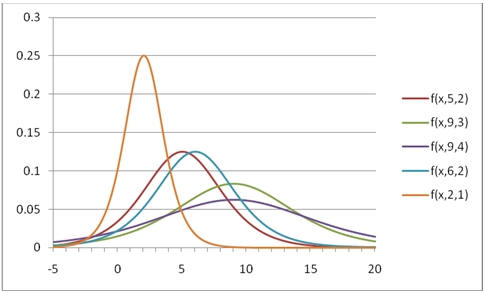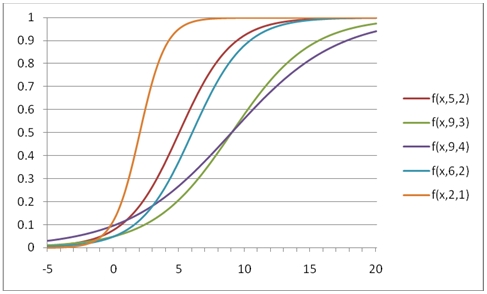SQL Server LOGISTIC Function
Updated 2024-03-08 21:27:18.487000
Description
Use the scalar function LOGISTIC to calculate the probability density function or the lower cumulative distribution function of the logistic distribution.
The formula for the probability density function is:
f(x;\mu,s)=\frac{1}{4s}\text{ sech}^2\left(\frac{x-\mu}{2s}\right)
The lower cumulative distribution function is:
F(x;\mu,s)=\frac{1}{2}+\frac{1}{2}\text{ tanh}\left(\frac{x-\mu}{2s}\right)
Syntax
SELECT [westclintech].[wct].[LOGISTIC] (
<@X, float,>
,<@A, float,>
,<@B, float,>
,<@Cumulative, bit,>)
Arguments
@X
is the value to be evaluated. @X is an expression of type float or of a type that implicitly converts to float.
@A
is the location parameter. @A is an expression of type float or of a type that implicitly converts to float.
@B
is the scale parameter. @B is an expression of type float or of a type that implicitly converts to float.
@Cumulative
is a logical value that determines if the probability density function ('False', 0) or the cumulative distribution function ('True', 1) is being calculated. @Cumulative is an expression of type bit or of a type that implicitly converts to bit.
Return Type
float
Remarks
@B must be greater than zero (@B > 0).
The upper cumulative distribution function is equal to 1 –LOGISTIC(@X, @A, @B, 'True').
Examples
Calculate the probability density function:
SELECT wct.LOGISTIC(1, 0, 1, 'False');
This produces the following result.
{"columns":[{"field":"column 1","headerClass":"ag-right-aligned-header","cellClass":"ag-right-aligned-cell"}],"rows":[{"column 1":"0.196611933241482"}]}
You can use the SeriesFloat function from the XLeratorDB/math library to generate a dataset which can be pasted into EXCEL to generate a graph of the probability density function.
SELECT SeriesValue,
wct.LOGISTIC(SeriesValue, 5, 2, 'False') as [f(x,5,2)],
wct.LOGISTIC(SeriesValue, 9, 3, 'False') as [f(x,9,3)],
wct.LOGISTIC(SeriesValue, 9, 4, 'False') as [f(x,9,4)],
wct.LOGISTIC(SeriesValue, 6, 2, 'False') as [f(x,6,2)],
wct.LOGISTIC(SeriesValue, 2, 1, 'False') as [f(x,2,1)]
FROM wct.SeriesFloat(-5, 20, .1, NULL, NULL);
This is an EXCEL-generated graph of the results,

Calculate the lower cumulative distribution function:
SELECT wct.LOGISTIC(1, 0, 1, 'True');
This produces the following result.
{"columns":[{"field":"column 1","headerClass":"ag-right-aligned-header","cellClass":"ag-right-aligned-cell"}],"rows":[{"column 1":"0.731058578630005"}]}
You can use the SeriesFloat function from the XLeratorDB/math library to generate a dataset which can be pasted into EXCEL to generate a graph of the cumulative distribution function.
SELECT SeriesValue,
wct.LOGISTIC(SeriesValue, 5, 2, 'True') as [f(x,5,2)],
wct.LOGISTIC(SeriesValue, 9, 3, 'True') as [f(x,9,3)],
wct.LOGISTIC(SeriesValue, 9, 4, 'True') as [f(x,9,4)],
wct.LOGISTIC(SeriesValue, 6, 2, 'True') as [f(x,6,2)],
wct.LOGISTIC(SeriesValue, 2, 1, 'True') as [f(x,2,1)]
FROM wct.SeriesFloat(-5, 20, .1, NULL, NULL);
This is an EXCEL-generated graph of the results.

Calculate the upper cumulative distribution function:
SELECT 1 - wct.LOGISTIC(1, 0, 1, 'True');
This produces the following result.
{"columns":[{"field":"column 1","headerClass":"ag-right-aligned-header","cellClass":"ag-right-aligned-cell"}],"rows":[{"column 1":"0.268941421369995"}]}